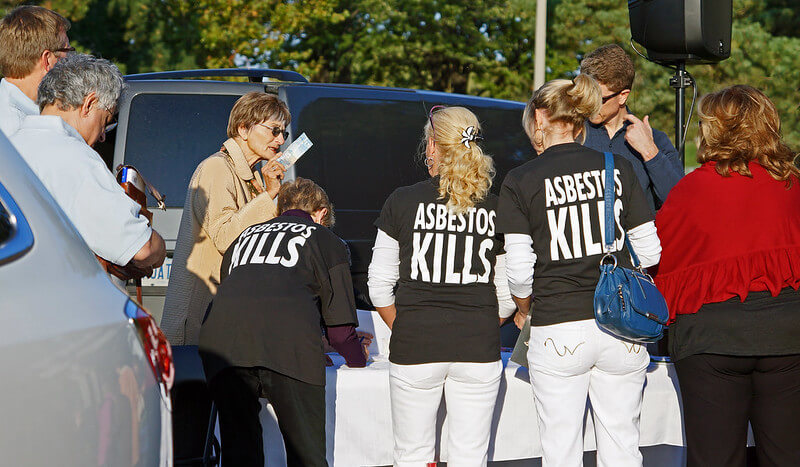
Walter Pacheco has worked at some of Florida's top newspapers, including the Miami Herald and the Orlando Sentinel. He has nearly 20 years of experience writing about breaking news, economic development, medical breakthroughs and technology.
Unions have been the backbone for many employees when it comes to raising awareness of dangerous workplace environments, including exposure to asbestos.

Labor unions have played a vital role in helping protect employees from toxic asbestos, pushing for safer working conditions, more robust legislation and fairer treatment. They’re considered leaders in the fight against asbestos, helping reduce the number of work-related cases of mesothelioma.
Although labor unions’ history traces back to the earliest days of the 20th century, their battle against asbestos exposure didn’t take off until the end of World War II in 1945. As more information became public about the connection between asbestos and diseases like mesothelioma cancer, unions helped bring it to light.
Reports showed workers exposed to asbestos were dying in disproportionate numbers. Unions supported workers and contributed to efforts to shine a light on negligence and efforts of asbestos product makers to hide the dangers, as well as the fact that many of these companies knew about the dangers and failed to warn the public.
Asbestos use ramped up in WWII when it was heavily used in the military shipyards, construction projects and transportation, exposing service members and civilian workers alike. Though concern grew about military asbestos exposure, asbestos became pervasive after World War II.
Because asbestos became synonymous with the post-war economic boom in North America, it left its imprint across industries. Construction, manufacturing, mining, shipbuilding, railroading and automobile production all widely used the toxic mineral.
This naturally occurring mineral was prized for its versatility, affordability and ability to fireproof and strengthen almost anything mixed with it. Despite its usefulness, inhaling microscopic asbestos fibers lead to many serious asbestos-related diseases like asbestosis, lung cancer and mesothelioma. Labor unions began seeing firsthand that asbestos fibers are toxic and their members were becoming ill.

Dozens of trade unions emerged in the 20th century, and some of the more influential ones still exist. Union involvement in the fight to protect workers has varied over the years, often depending on what trade or industry was affected.
Active Unions That Protected Workers From Asbestos
Unions are best known for bargaining to improve wages, benefits and working conditions. Still, they have also been equally instrumental in protecting workers from unsafe conditions and toxic materials like asbestos.
These organizations warned employees and companies about the dangers of asbestos nearly 70 years ago. Unions sounded the alarm, even in the early years, long before legislation began more strictly controlling asbestos.
The United Steelworkers Union has lobbied Congress for decades, asking for amendments to the Toxic Substances Control Act to better protect workers. In 2013, for example, the union submitted an official report to Congress.
The official submitted report stated, “Asbestos is still in commercial use in the United States. The EPA has not tried to ban a substance since the ruling on asbestos 22 years ago.” In 2024, the Biden Administration started a lengthy phasing out of chrysotile asbestos; however, the EPA in 2025, now under the Trump administration, is reconsidering the former administration’s decision to ban the ongoing use of chrysotile asbestos.
Unions have been instrumental in the legislative process for many years. They’ve been fighting proposed bills in Congress since 2005 that aim to weaken the ability of harmed workers to hold companies legally accountable for negligence.
On the state level, labor unions are battling business-backed legislative efforts today to make filing mesothelioma lawsuits more difficult for workers.

You shouldn’t have to choose between getting care and paying for it. Get the financial support you deserve.
See My OptionsFor many years, the International Association of Heat and Frost Insulators & Allied Workers has led important efforts to support its members facing asbestos risks. One major initiative was the Health Hazard Screening Program, which offered help to workers and their families.
Another key effort was the Political Action Fund, which ensured the union’s concerns were heard in Congress. The union also created an Instructor Training Program focused on asbestos removal. This program gave members the tools and knowledge to better protect themselves. A message repeated throughout the union’s website is that “it is the workers’ right to know when they are in danger.”
The union also published many educational materials about asbestos for its members. These included books and brochures with titles like: “Danger—Asbestos Kills, A Worker’s Guide to Health Rights,” “Don’t Let Asbestos Kill Your Wife and Children” and “Here’s How to Protect Yourself.”
In addition to lobbying for better worker protections, unions help their members find the legal and medical assistance they need. They can help their members get help from mesothelioma lawyers who specialize in the complexities of asbestos-related injury cases.
They also support advocacy and awareness efforts that can help union members. In 2024, for example, the International Association of Fire Fighters and the Asbestos Disease Awareness Organization teamed up to unveil a massive Times Square billboard urging a nationwide asbestos ban. Featuring a firefighter and the message “Ban Asbestos Now,” the awareness campaign aimed to bring attention to the danger asbestos poses to firefighters, push for legislative action and protect first responders.
Unions have led the push for early and regular health screenings for asbestos-exposed workers. The Capitol Police Union filed a formal complaint with Washington, D.C.’s Office of Compliance over asbestos exposure risks to its officers. And the Firefighters Union in Everett, Washington, fought for and secured lifetime medical monitoring for members exposed to asbestos during a training exercise from the city.
Unions have also fought for fairness in assigning asbestos handling and removal tasks. Data from New York City showed 76% of asbestos removal work in 2020 was assigned to minority workers. Unions have been working to make sure tasks like this are assigned fairly.
Recommended ReadingStay up-to-date on treatment, research, clinical trials, doctors and survivors
The information on this website is proprietary and protected. It is not a substitute for professional medical advice, diagnosis or treatment. Any unauthorized or illegal use, copying or dissemination will be prosecuted. Please read our privacy policy and terms of service for more information about our website.
This website and its content may be deemed attorney advertising. Prior results do not predict a similar outcome.
The Mesothelioma Center’s claim as the most trusted resource is based on our more than 150 5-star Google and BBB reviews. Our organization also helps more than half of all mesothelioma patients annually diagnosed.
Your web browser is no longer supported by Microsoft. Update your browser for more security, speed and compatibility.
If you are looking for mesothelioma support, please contact our Patient Advocates at (855) 404-4592
The Mesothelioma Center at Asbestos.com has provided patients and their loved ones the most updated and reliable information on mesothelioma and asbestos exposure since 2006.
Our team of Patient Advocates includes a medical doctor, a registered nurse, health services administrators, veterans, VA-accredited Claims Agents, an oncology patient navigator and hospice care expert. Their combined expertise means we help any mesothelioma patient or loved one through every step of their cancer journey.
More than 30 contributors, including mesothelioma doctors, survivors, health care professionals and other experts, have peer-reviewed our website and written unique research-driven articles to ensure you get the highest-quality medical and health information.
My family has only the highest compliment for the assistance and support that we received from The Mesothelioma Center. This is a staff of compassionate and knowledgeable individuals who respect what your family is experiencing and who go the extra mile to make an unfortunate diagnosis less stressful. Information and assistance were provided by The Mesothelioma Center at no cost to our family.LashawnMesothelioma patient’s daughter


Asbestos.com. (2025, September 25). Labor Unions and Asbestos Exposure. Retrieved December 23, 2025, from https://www.asbestos.com/asbestos/labor-unions/
"Labor Unions and Asbestos Exposure." Asbestos.com, 25 Sep 2025, https://www.asbestos.com/asbestos/labor-unions/.
Asbestos.com. "Labor Unions and Asbestos Exposure." Last modified September 25, 2025. https://www.asbestos.com/asbestos/labor-unions/.

Walter Pacheco has worked at some of Florida's top newspapers, including the Miami Herald and the Orlando Sentinel. He has nearly 20 years of experience writing about breaking news, economic development, medical breakthroughs and technology.
Our fact-checking process begins with a thorough review of all sources to ensure they are high quality. Then we cross-check the facts with original medical or scientific reports published by those sources, or we validate the facts with reputable news organizations, medical and scientific experts and other health experts. Each page includes all sources for full transparency.
Please read our editorial guidelines to learn more about our content creation and review process.
